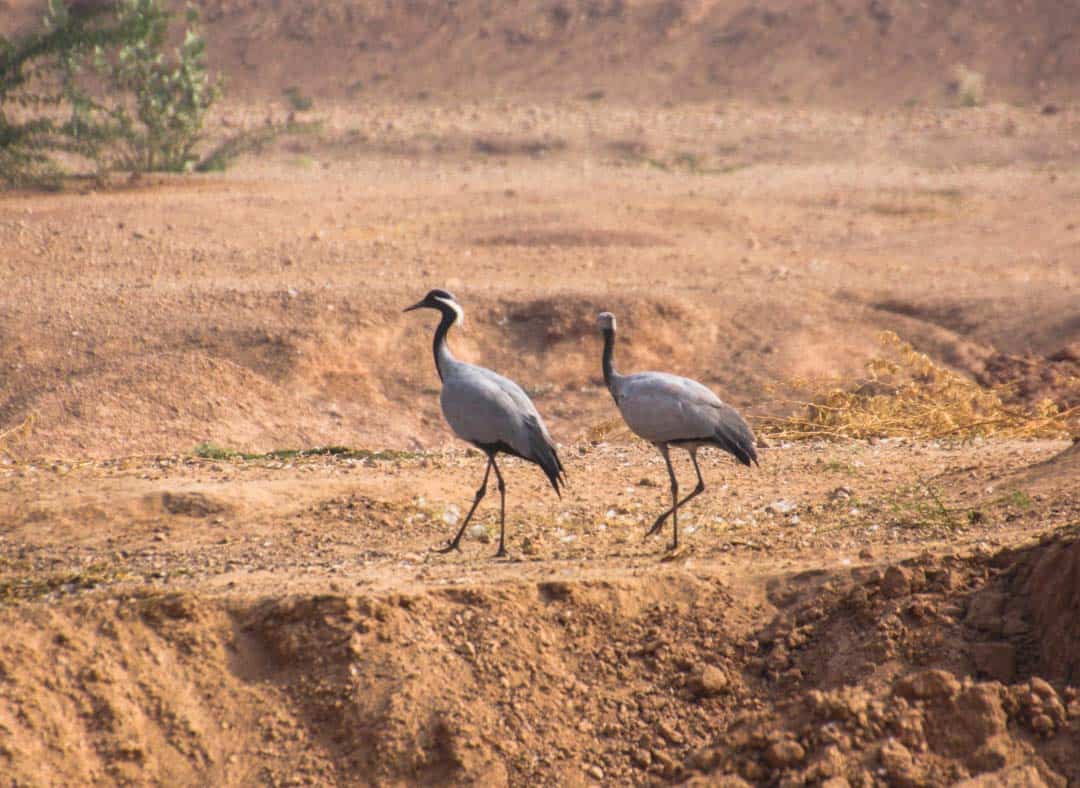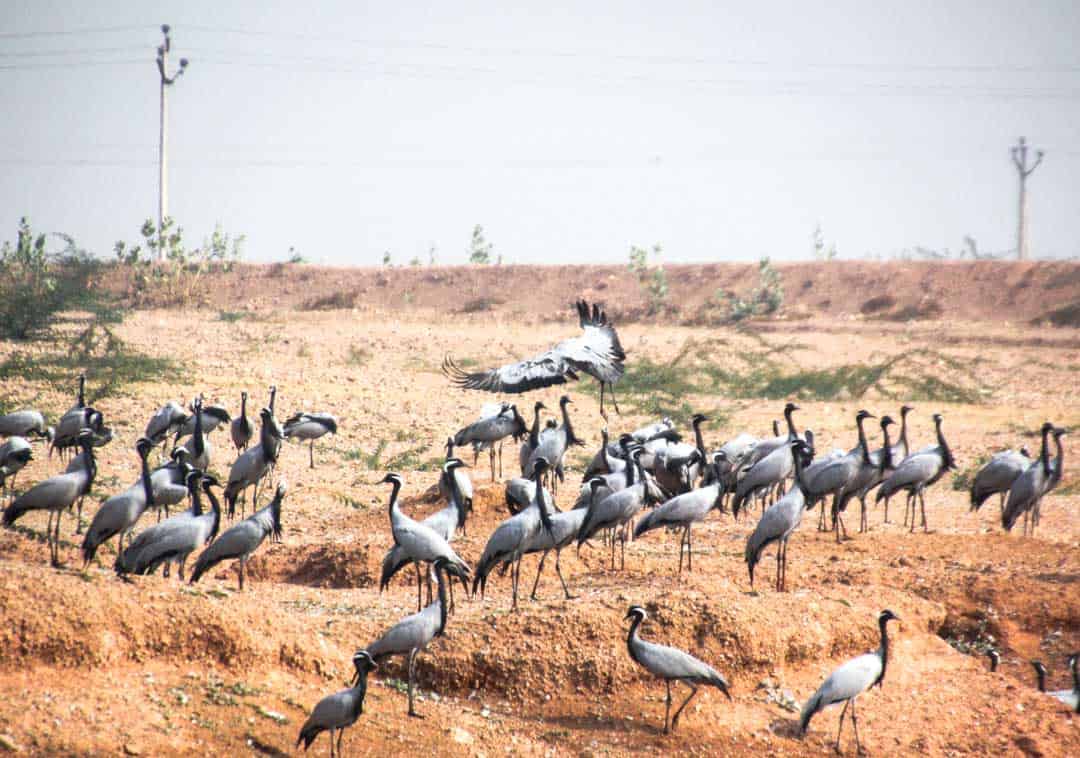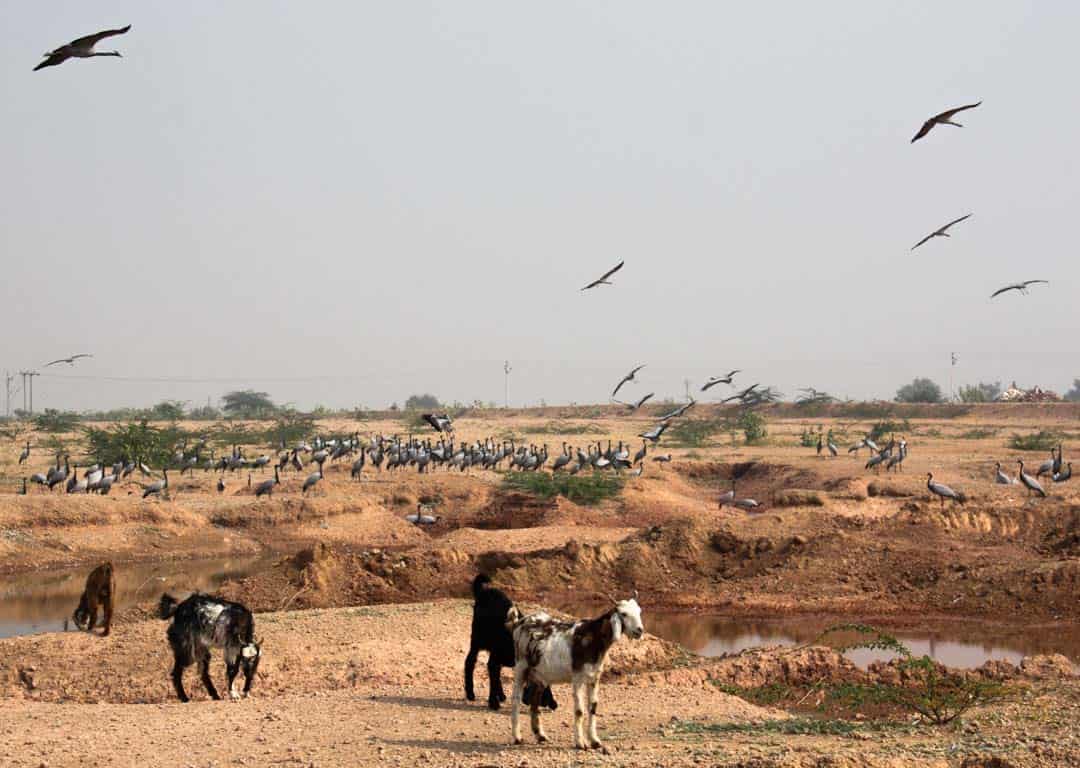Around 150-kilometres north of Jodhpur in India’s state of Rajasthan, the dusty town of Khichan emerges through a dusty haze. At first glance, there’s nothing extraordinary about this small village in the parched landscape of the Thar Desert. It’s an unlikely place for a wildlife spectacle.
But for one bird species, the elegant demoiselle crane, the Khichan Bird Sanctuary is a paradise worth migrating across a continent for.

Our encounter with the demoiselle cranes of Khichan came during an epic journey of our own through Rajasthan, India’s ancient ‘Land of Kings’: a month-long road trip taking in the cities and villages from the country’s capital of New Delhi to the western outpost desert fortress of Jaisalmer near the border with Pakistan.
We’d left behind the bustling streets of Bikaner in the State’s northwest – a town famous for its vast Junagarh Fort and the nearby rat temple of Karni Mata – and set off west for the desert outpost of Jaisalmer.
Glancing through our guidebook the night before, I found a short passage about a village en route called Khichan. There, the locals had inadvertently created a bird sanctuary so successful in attracting and protecting demoiselle cranes, that some 15,000 birds now flocked to the area each migration season from their breeding grounds across Asia and Mongolia. It was the right time of year. As bird nerds, we had to see it.
The industrious sounds of a village hard at work filled the air when we finally arrived in Khichan on that hazy winter’s day. Rickshaws and motorbikes stuttered loudly through the streets. Above the mechanical din though, we could hear the honking of the village’s feathery guests.
Early morning is said to be the best time to witness the aerial arrival of the demoiselle cranes en masse at the Khichan Bird Sanctuary, but turning up around midday, we made our way instead to the village ponds, where we were told the birds retreat to when the sun is high.
The landscape that greeted us was flat and dusty, with muddy pools of water carving ravines through the soil. Dry, spindly scrub scattered the parched dirt. We spotted the birds immediately. Demoiselle cranes clustered by the dozens around the ponds, preening their delicate grey and black plumage as compatriots swooped in to join them.

The Khichan crane story began in the 1970s, with a local Jain family feeding pigeons. Jainism is an ancient Indian religion, one tenet of which is no harm to animals, and the villagers welcomed the birds.
The daily feeding began to attract some of the demoiselle cranes already migrating to nearby areas. Those birds apparently spread the word, and more and more cranes began visiting Khichan each year for their seasonal Indian stay-cation, which lasts from late August to March.
Eventually, with avian numbers rising dramatically, the family who fed the birds built an enclosure on the outskirts of the village to protect the cranes from the increasing threat of dogs and encroaching human settlement.
Today, the Khichan Bird Sanctuary is the focal point for the demoiselle crane migration in the region, and a centre for bird watching in India. Each day during the season’s peak, at around 7am and 3pm, visitors can witness the noisy, feathery spectacle of thousands of cranes – each with a wingspan of up to 1.8-metres – descending on the enclosure to feast on hundreds of kilos of grain.
Come March, it’s time for the demoiselle cranes to leave behind the easy life of their bird sanctuary in Kichan. Their breeding grounds await across the Himalayas, but their high-altitude migration is a perilous one.
For those that make it back over the mountains to their summer homes in Central Asia, China and Mongolia, the next couple of months will be tied up with breeding, nesting and telling their friends about the all-inclusive resort they winter at in a small Indian village called Khichan.

Back in the car and on the road north once more, we were left to ponder the curious story of the well-intentioned Jains who fed a couple of pigeons each day, which led to the surprise creation of a protective sanctuary for thousands of cranes making one of the world’s toughest annual wildlife migrations.
A cautionary tale about feeding the wildlife? Or a positive story of human-wildlife interaction? Either way, meeting the cranes of Khichan was a quirky highlight of an epic road trip through Rajasthan.
Good to know
Getting to Khichan: Khichan is located in the northern state of Rajasthan in India, around 160-kilometres southwest of the city of Bikaner, or 150-odd kilometres northwest of Jodhpur (a drive of around 2.5-3 hours from either).
When to go: The demoiselle cranes are in Khichan between late August and March each year, however peak season for the birds is November to February.
Cost: The grain that feeds Khichan’s cranes is paid for through donations by locals and a fee for tourists of around 15 rupees (which is roughly 20 cents).
Got a question or comment? Drop us a message below! Head over to our India page for more posts on this vibrant country. Or, for more wonderful wildlife, check out our wildlife page.

Being a jain myself, i am curious to know what is the connection between jains & khichan / crane feeding. And yes you are right, we feed pigeons daily. I have seen my mother feed them since my entire life of 50 years. and i too do this ritual almost everyday.
Hi Rajesh, thanks for your message and interest in this post! The story of the Khichan Crane Sanctuary – as it was told to us – is that it came about directly because of a local Jain family feeding pigeons and their subsequent welcome and care for the demoiselle cranes as they came in larger and larger numbers. It was through their connection with and care for wildlife that the sanctuary exists today. It’s lovely to hear that you too care for local birds! All the best.
Incredible I wish America invested more in our wildlife so many people could benefit from wildlife exploration, there’s a peace you find in God’s creatures untouched by man
Amazing story.
Thanks Cynthia, glad you liked it.